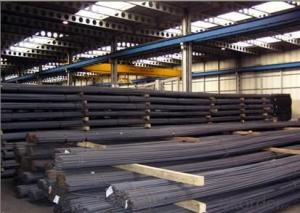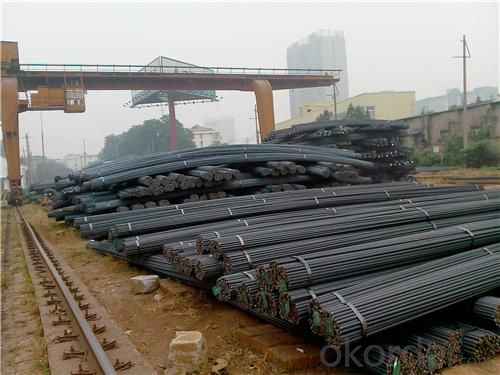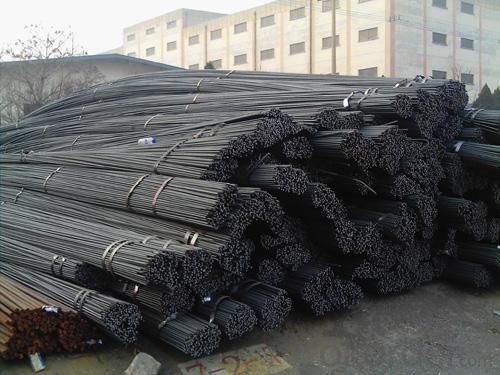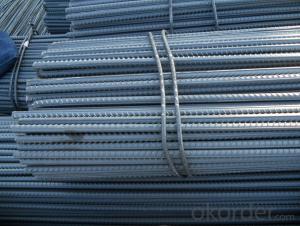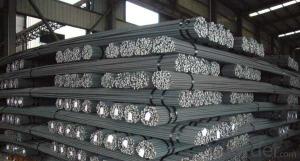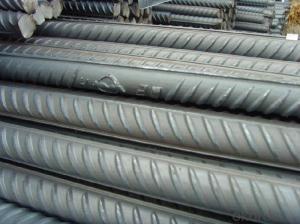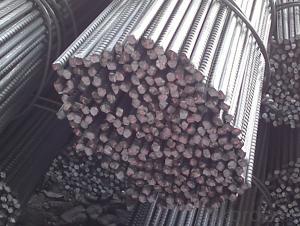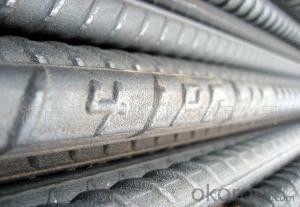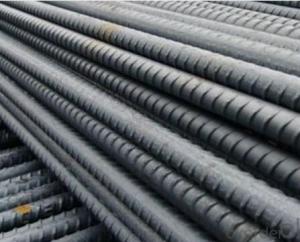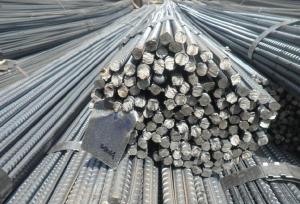ASTM A615 deformed steel bar for construction
- Loading Port:
- Tianjin
- Payment Terms:
- TT OR LC
- Min Order Qty:
- 25 m.t.
- Supply Capability:
- 100000 m.t./month
OKorder Service Pledge
OKorder Financial Service
You Might Also Like
Usage and Applications of Construction
1. Construction steel round bar is mostly used for straight bundles supply, and used for steel, bolts and various mechanical parts. While the bigger round bar, or more than 25mm hot rolled bar, is mainly for the manufacture of mechanical parts or for seamless steel billet.
2. Steel round bar is used in construction and a large number of architectural and engineering structures.
3. Besides, we can supply some especial material steel round bar that can be used for main shaft of steamer, hummer shank, with big section and supper force.
Packaging & Delivery
Packaging Detail: All goods are packed in bundle with steel strips and shipped by break bulk vessel or container (depend on target market and different ports)
Delivery Detail: 45 days
Trade terms: FOB, CFR, CIF
MOQ: 25 tons per specification; we can negotiate the quantity if the specification is normal or we have stock of one specification.
Weight: Theprice invoicing on theoretical weight basis or actual weight basis depends on customer’s request.
Shipment: The shipment of bulk break or container is depends on customer’s request and the situation of the port of destination.
Documents given: Full set of original clean on board bill of lading; Original signed commercial invoice; Original packing list; Policy of insurance; Certificate of origin and what the target market needs.
Note:
1. Our products are produced according to national standard (GB), if not, supply according to national standards (GB) or agreement as customer required.
2. Other Grade and Standard Deformed Steel Bar we can supply:
Grade: GR40/GR60, G460B/B500A/B500B/B500C,BST500S
Standard: ASTM, BS, DIN
The Minimum Order Quantity of these products is high, and need to be confirmed.
3. We can not only supply Deformed Steel Bar; if you need anything about building materials, please contact us for further information.
4. Please send us your detail specifications when inquire. We will reply to you as soon as possible. We sincerely hope we can establish a long stable business relationship
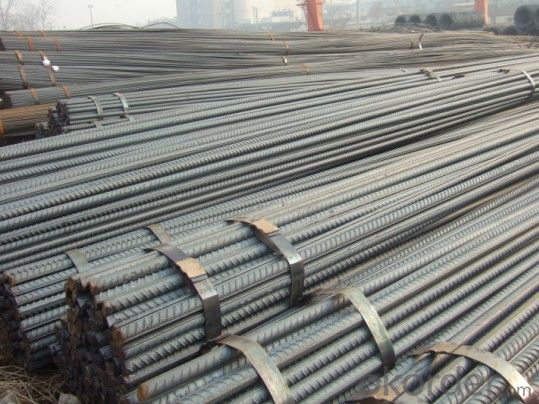
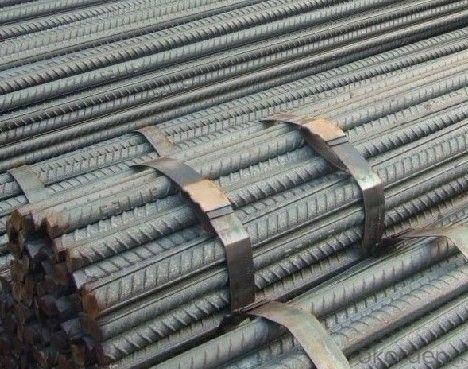
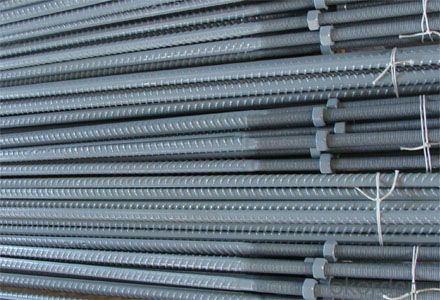
- Q: How do steel rebars impact the overall construction cost estimation process?
- The overall construction cost estimation process is significantly influenced by steel rebars. These reinforcing bars play a crucial role in reinforced concrete structures, providing strength and durability to the building. Consequently, including them in the cost estimation is essential for accurately assessing the total project cost. To begin with, the material cost of the construction project is impacted by steel rebars. Rebars are typically priced based on weight, so the quantity and size of rebars required directly affect the material cost estimation. Accurately identifying and quantifying rebars is necessary to ensure an appropriate budget allocation for the project. Furthermore, labor cost estimation is also influenced by steel rebars. Skilled labor is required to install rebars, and the time and effort involved in cutting, bending, and placing the rebars must be taken into account. The complexity of the reinforcement design, such as intricate shapes or complex detailing, can increase labor costs. Therefore, accurately estimating rebars allows for better planning of labor resources and cost allocation. In addition to material and labor costs, steel rebars impact other aspects of the construction cost estimation process. For example, the weight and placement of rebars affect the structural design, which can influence the cost estimation of the concrete mix design and formwork requirements. The size and spacing of rebars may also impact the excavation and foundation costs, as well as the overall project timeline. Moreover, steel rebars contribute to the long-term costs of the construction project. The quality and durability of rebars directly affect the lifespan and maintenance requirements of the structure. Investing in high-quality rebars can reduce future maintenance and repair costs, as well as enhance the overall life cycle cost analysis of the project. To conclude, the overall construction cost estimation process is significantly impacted by steel rebars. Accurately estimating rebars is essential for determining material and labor costs, as well as influencing other cost-related aspects of the project. It allows for precise budget allocation, resource planning, and consideration of long-term costs, ultimately resulting in a more reliable and comprehensive construction cost estimation.
- Q: Can steel rebars be used in water treatment facilities?
- Yes, steel rebars can be used in water treatment facilities. Steel rebars are commonly used in the construction of various structures, including water treatment facilities. They provide strength and durability to the concrete structures, ensuring their stability and longevity in the harsh environment of water treatment facilities.
- Q: What are the different types of steel rebars used in road constructions?
- Road constructions commonly utilize various types of steel rebars. These include: 1. Mild steel rebars: These are the most frequently employed rebars in road constructions. They consist of low carbon steel and possess a smooth surface. Mild steel rebars are renowned for their durability and strength, making them suitable for a range of road construction applications. 2. High-strength rebars: Crafted from high-strength steel, these rebars possess a greater yield strength compared to mild steel rebars. They are utilized in road constructions that require enhanced load-bearing capacity, such as bridges and highways. 3. Epoxy-coated rebars: These rebars are coated with epoxy resin to enhance their resistance to corrosion. They are commonly used in road constructions in areas exposed to moisture and chemicals, such as coastal regions. 4. Galvanized rebars: These rebars feature a zinc coating that provides protection against corrosion. They are particularly suitable for road constructions in regions with high humidity or a high risk of corrosion. 5. Stainless steel rebars: Constructed from stainless steel, these rebars exhibit exceptional corrosion resistance. They are frequently employed in road constructions that necessitate long-term durability and resistance to corrosion, such as tunnels and underground structures. Selecting the appropriate type of steel rebar for road constructions is crucial and should be based on specific project requirements, including load-bearing capacity, exposure to corrosion, and environmental conditions. Consulting structural engineers and adhering to local construction codes and standards is essential to ensure the successful implementation of road construction projects.
- Q: What are the different types of coatings available for steel rebars to prevent corrosion?
- To prevent corrosion, different coatings are available for steel rebars. These coatings serve as a barrier between the steel rebar and its surroundings, effectively preventing or minimizing the corrosion process. The range of coatings includes: 1. Epoxy Coating: Widely used, this thermosetting polymer creates a strong and durable protective layer. It is known for its excellent resistance to chemicals and abrasion. 2. Zinc Coating: Utilized in hot-dip galvanization, zinc coatings act as sacrificial anodes, corroding in place of the steel rebar and safeguarding it from oxidation. 3. Fusion-Bonded Epoxy Coating: By melting epoxy powder onto the steel rebar's surface, a robust bond is formed. This coating is resistant to corrosion, chemicals, and moisture. 4. Polymer Coating: Coatings like polyethylene or polypropylene form a protective layer against corrosion. They exhibit high resistance to chemicals, abrasion, and moisture, ensuring long-term protection. 5. Concrete Coating: When properly applied, concrete can act as a protective coating for steel rebars. The alkaline nature of concrete facilitates the formation of a protective oxide layer, preventing further corrosion. 6. Stainless Steel Coating: The application of a thin layer of stainless steel significantly enhances corrosion resistance. Stainless steel coatings offer exceptional durability and resistance in harsh environments. Selecting the appropriate coating is crucial, considering the specific application and environmental conditions, to achieve optimal protection against corrosion for steel rebars.
- Q: How do steel rebars prevent the concrete from cracking under tension?
- Steel rebars prevent concrete from cracking under tension by providing reinforcement and increasing the tensile strength of the concrete. When the concrete undergoes tensile stress, which is the force that tends to pull it apart, the rebars distribute the stress across a larger area and absorb some of the tension. This helps to prevent the concrete from cracking by reducing the amount of stress applied to any one area and providing additional strength to withstand the forces acting upon it.
- Q: Are steel rebars suitable for use in high-rise buildings?
- Yes, steel rebars are suitable for use in high-rise buildings. Steel rebars, also known as reinforcing bars, are commonly used in the construction industry to provide strength and stability to concrete structures. High-rise buildings require a strong and durable structural system to withstand various loads and forces such as wind, earthquakes, and the weight of the building itself. Steel rebars offer excellent tensile strength and ductility, making them ideal for reinforcing concrete in high-rise structures. One of the key advantages of steel rebars is their ability to resist tensile forces. Concrete is strong in compression but weak in tension, and steel rebars help counteract this weakness by providing the necessary tensile strength. This is crucial in high-rise buildings where the weight of the structure can cause tension on the concrete elements. By reinforcing the concrete with steel rebars, the overall structural integrity of the building is enhanced, ensuring its safety and stability. Additionally, steel rebars have superior ductility, which is the ability to deform under stress without fracturing. This property is essential in high-rise buildings as they are subject to dynamic loads and potential movements caused by factors like wind or seismic activity. Steel rebars can absorb and distribute these forces, reducing the risk of structural failure or collapse. Furthermore, steel rebars are readily available and cost-effective compared to alternative materials such as carbon fiber or fiberglass. They can be easily fabricated and installed in various shapes and sizes to fit the specific design requirements of high-rise buildings. However, it is important to note that the suitability of steel rebars in high-rise buildings also depends on proper design, installation, and regular maintenance. It is crucial to follow the relevant building codes and standards, ensure proper corrosion protection, and conduct regular inspections to detect any potential issues. By adhering to these practices, steel rebars can provide a reliable and durable reinforcement solution for high-rise buildings.
- Q: What are the guidelines for proper spacing and arrangement of steel rebars in concrete structures?
- The guidelines for proper spacing and arrangement of steel rebars in concrete structures typically include requirements for minimum clear spacing between rebars, minimum concrete cover over the rebars, and maximum spacing between adjacent rebars. These guidelines are designed to ensure adequate reinforcement within the concrete, promote structural integrity, and prevent corrosion of the rebars.
- Q: What is the importance of proper alignment of steel rebars in a structure?
- The proper alignment of steel rebars in a structure is crucial for several reasons. Firstly, it ensures structural integrity and strength by distributing loads evenly and resisting forces such as compression, tension, and shear. Improperly aligned rebars can lead to weak points, compromising the stability and safety of the structure. Secondly, proper alignment helps maintain the desired shape and dimensions of the structure. It ensures that the rebars are positioned correctly to support the concrete during pouring, preventing any deformations or irregularities that could impact the overall aesthetics and functionality of the finished structure. Additionally, aligned rebars facilitate efficient construction processes. When rebars are correctly placed, it simplifies the process of pouring concrete, reducing the likelihood of delays or errors during construction. It also allows for easy placement of formwork, enabling smoother and faster construction progress. Lastly, proper alignment of rebars contributes to the longevity and durability of the structure. By ensuring the rebars are correctly positioned, the risk of corrosion and deterioration is minimized. This helps to prolong the lifespan of the structure, reducing maintenance and repair costs in the long run. In conclusion, the importance of proper alignment of steel rebars in a structure cannot be overstated. It enhances structural strength, maintains shape and dimensions, supports efficient construction processes, and increases the longevity of the structure.
- Q: Can steel rebars be used in the construction of shopping centers?
- Yes, steel rebars can be used in the construction of shopping centers. Steel rebars are commonly used in reinforced concrete structures, including commercial buildings like shopping centers, as they provide strength, durability, and resistance to structural forces.
- Q: Can steel rebars be used in industrial flooring?
- Industrial flooring can indeed incorporate steel rebars, as they possess remarkable tensile strength and durability. The incorporation of steel rebars in concrete construction, particularly in industrial flooring, is a widespread practice. These rebars are strategically positioned within the concrete to reinforce it and provide additional strength, enabling it to withstand heavy loads and prevent cracking. By utilizing steel rebars in industrial flooring, the capacity to bear weight is significantly augmented, and the floor's longevity and structural integrity are assured. Furthermore, steel rebars can be effortlessly welded or linked together to form a grid or mesh, further enhancing the floor's strength and stability. Hence, steel rebars are a suitable choice for industrial flooring applications.
Send your message to us
ASTM A615 deformed steel bar for construction
- Loading Port:
- Tianjin
- Payment Terms:
- TT OR LC
- Min Order Qty:
- 25 m.t.
- Supply Capability:
- 100000 m.t./month
OKorder Service Pledge
OKorder Financial Service
Similar products
Hot products
Hot Searches
Related keywords
